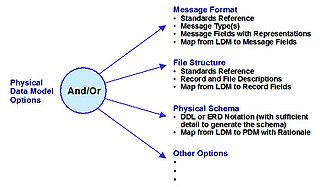
A database is an organized collection of data, generally stored and accessed electronically from a computer system. Where databases are more complex they are often developed using formal design and modeling techniques.

MySQL is an open-source relational database management system (RDBMS). Its name is a combination of "My", the name of co-founder Michael Widenius's daughter, and "SQL", the abbreviation for Structured Query Language. A relational database organizes data into one or more data tables in which data types may be related to each other; these relations help structure the data. SQL is a language programmers use to create, modify and extract data from the relational database, as well as control user access to the database. In addition to relational databases and SQL, an RDBMS like MySQL works with an operating system to implement a relational database in a computer's storage system, manages users, allows for network access and facilitates testing database integrity and creation of backups.
SAP ASE , originally known as Sybase SQL Server, and also commonly known as Sybase DB or Sybase ASE, is a relational model database server developed by Sybase Corporation, which later became part of SAP AG. ASE is predominantly used on the Unix platform, but is also available for Microsoft Windows.

A physical data model is a representation of a data design as implemented, or intended to be implemented, in a database management system. In the lifecycle of a project it typically derives from a logical data model, though it may be reverse-engineered from a given database implementation. A complete physical data model will include all the database artifacts required to create relationships between tables or to achieve performance goals, such as indexes, constraint definitions, linking tables, partitioned tables or clusters. Analysts can usually use a physical data model to calculate storage estimates; it may include specific storage allocation details for a given database system.
MySQL Cluster is a technology providing shared-nothing clustering and auto-sharding for the MySQL database management system. It is designed to provide high availability and high throughput with low latency, while allowing for near linear scalability. MySQL Cluster is implemented through the NDB or NDBCLUSTER storage engine for MySQL.
The following tables compare general and technical information for a number of relational database management systems. Please see the individual products' articles for further information. Unless otherwise specified in footnotes, comparisons are based on the stable versions without any add-ons, extensions or external programs.
The Microsoft Jet Database Engine is a database engine on which several Microsoft products have been built. The first version of Jet was developed in 1992, consisting of three modules which could be used to manipulate a database.
MyISAM was the default storage engine for the MySQL relational database management system versions prior to 5.5 released in December 2009. It is based on the older ISAM code, but it has many useful extensions.

H2 is a relational database management system written in Java. It can be embedded in Java applications or run in client-server mode.
Microsoft SQL Server is a relational database management system developed by Microsoft. As a database server, it is a software product with the primary function of storing and retrieving data as requested by other software applications—which may run either on the same computer or on another computer across a network. Microsoft markets at least a dozen different editions of Microsoft SQL Server, aimed at different audiences and for workloads ranging from small single-machine applications to large Internet-facing applications with many concurrent users.

Raima Database Manager is an ACID-compliant embedded database management system designed for use in embedded systems applications. RDM has been designed to utilize multi-core computers, networking, and on-disk or in-memory storage management. RDM provides support for multiple application programming interfaces (APIs): low-level C API, C++, and SQL(native, ODBC, JDBC, ADO.NET, and REST). RDM is highly portable and is available on Windows, Linux, Unix and several real-time or embedded operating systems. A source-code license is also available.
An embedded database system is a database management system (DBMS) which is tightly integrated with an application software that requires access to stored data, such that the database system is "hidden" from the application’s end-user and requires little or no ongoing maintenance. It is actually a broad technology category that includes
Aria is a storage engine for the MariaDB and MySQL relational database management systems. Its goal is to make a crash-safe alternative to MyISAM. It is not transactional.
LevelDB is an open-source on-disk key-value store written by Google fellows Jeffrey Dean and Sanjay Ghemawat. Inspired by Bigtable, LevelDB is hosted on GitHub under the New BSD License and has been ported to a variety of Unix-based systems, and macOS, Windows, and Android.
TokuDB is an open-source, high-performance storage engine for MySQL and MariaDB. It achieves this by using a fractal tree index. It is scalable, ACID and MVCC compliant, provides indexing-based query improvements, offers online schema modifications, and reduces replication lag for both hard disk drives and flash memory.
This is a comparison between notable database engines for the MySQL database management system (DBMS). A database engine is the underlying software component that a DBMS uses to create, read, update and delete (CRUD) data from a database.

SingleStore is a distributed, relational, SQL database management system (RDBMS) that features ANSI SQL support and is known for speed in data ingest, transaction processing, and query processing. SingleStore was formerly known as MemSQL.
In relational databases a virtual column is a table column whose value is automatically computed using other columns values, or another deterministic expression. Virtual columns are defined of SQL:2003 as Generated Column, and are only implemented by some DBMSs, like MariaDB, SQL Server, Oracle, SQLite and Firebird.
The following outline is provided as an overview of and topical guide to MySQL:
RocksDB is a high performance embedded database for key-value data. It is a fork of Google's LevelDB optimized to exploit many CPU cores, and make efficient use of fast storage, such as solid-state drives (SSD), for input/output (I/O) bound workloads. It is based on a log-structured merge-tree data structure. It is written in C++ and provides official language bindings for C++, C, and Java; alongside many third-party language bindings. RocksDB is open-source software, and was originally released under a BSD 3-clause license. However, in July 2017 the project was migrated to a dual license of both Apache 2.0 and GPLv2 license, possibly in response to the Apache Software Foundation's blacklist of the previous BSD+Patents license clause.